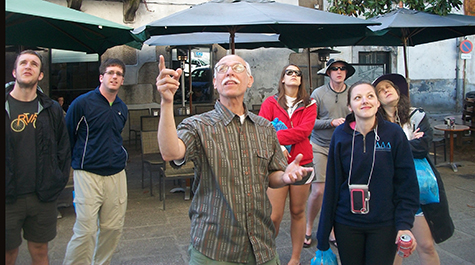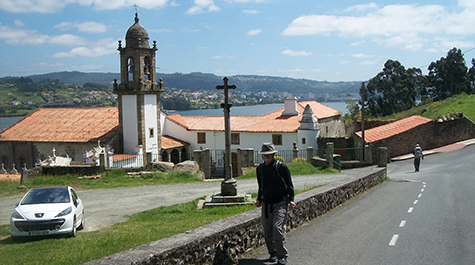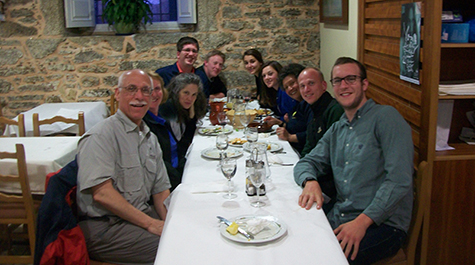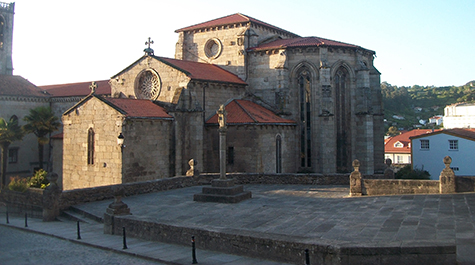A Pilgrim's Reward
Even in retirement, George D. Greenia, professor emeritus of modern languages, leads a peripatetic and intentional life. Over the last year, he has lectured at diverse universities (Yale, Stanford, Texas Tech, Georgetown, Cal State Fresno, to name a few); in London and Durham in England; Asheville, North Carolina; Belgrade and Dublin, and he will lead a pilgrimage in Spain for the Smithsonian Institution this fall.
In the midst of these journeys, he will travel to Mexico to add another honor to his already extensive C.V. Greenia has been selected the 2019 recipient of the International Prize Grupo Compostela–Xunta de Galicia.
The Compostela Group (CGU) is one of the world’s largest non-profit consortia of higher education institutions. Created in 1993 by a group of European universities, the CGU currently brings together more than 70 members on four continents. Its mission is to facilitate cooperation among universities to preserve historical and cultural heritage.
In cooperation with the Xunta de Galicia (Galicia’s Department of Culture, Social Communication and Tourism), CGU awards an annual prize to a European individual or group who has made a major contribution to European values in the educational, cultural or social fields.
The CGU honors Greenia for his “prolific academic trajectory, connection with Galicia and contribution to the dissemination of the Jacobean phenomenon.”
The award ceremony will take place June 4, 2019, during the 25th General Assembly of the Compostela Group of Universities, at the University of Guadalajara. At the ceremony, Greenia will receive a golden shell, the symbol of the Compostela Group, and a cash award that Greenia will donate to William & Mary’s Institute for Pilgrimage Studies.
Greenia is the first American to receive the honor, and he joins a prestigious circle of winners. Previous honorees include Václav Havel, Czech statesman and writer; Carla del Ponte, General Prosecutor at the International Criminal Tribunal for the Former Yugoslavia and Rwanda, and Swiss Attorney-General; and Wladyslaw Bartoszewski, an Auschwitz concentration camp survivor, member of the Polish underground, historian and politician instrumental in Polish-German reconciliation.
Greenia has had a long and successful academic career and is no stranger to awards and honors. He is co-founder of the William & Mary Program in Medieval & Renaissance Studies and founder of its Institute for Pilgrimage Studies. Greenia is an officer of the Alpha Chapter of the Phi Beta Kappa Society. For six years, he served on the society’s national senate and executive committee. In 2015, he earned the society’s President’s Award and Judith Krug Medal for distinguished service to PBK on a national level, only the third recipient in the Society’s history.
Fluent in Spanish, French and Latin, he is an authority on medieval material culture, especially its books and written culture, religious traditions, medieval travel and art. Between authored and edited work, he has produced over 30 volumes and some 8,000 pages of published scholarship. Greenia has given hundreds of presentations to academic, religious and civic groups.
An internationally recognized authority on medieval and modern pilgrimage, Greenia has bicycled and walked over 4,000 miles along the pilgrimage trails to Santiago de Compostela and to other sacred and patriotic sites in Europe and the Americas.
In 2007, Greenia was knighted and received the Encomienda of the Order of Isabel the Catholic by order of King Juan Carlos I for promotion of Spanish literature and culture in the United States.
This award from CGU, however, has special significance for Greenia.
“The Compostela Prize strengthens our ability to communicate the importance of Camino de Santiago as a model for other world pilgrimages,” he said. “Much of my research career centers on medieval and modern pilgrimage to the traditional shrine of St. James in Galicia, a trek that figures large in European history as a historic tidal movement of people, ideas and cultures. The modern revival of pilgrim traffic on medieval pathways proves the timeless draw of intentional travel that’s far more values-driven than mere tourism.”
A pilgrimage by nature is intensely personal. “It’s a therapeutic process that’s self-monitored and self-assigned,” Greenia explains. However, for Greenia, the impact and potential of the prize extends beyond himself to his fellow pilgrims and to his institution. He has taken — and continues to take — William & Mary on this journey with him and shares in its successes. “The award means we’re now recognized at a level of international importance.”
Although he has spearheaded pilgrimage studies at William & Mary, he is expansive in his praise of his colleagues who have led pilgrimages and put their own “stamp” on the experience.
“We have terrific people making highly original contributions, such as Kevin Vose,”he said, referencing the professor of religious studies who led a study abroad program to Bhutan last summer.
He also praises Matthew Allar (associate professor of theatre/scenographer); Ben Boone (associate director of the Center for Liberal Arts), Jim Barber (associate professor of education); and Kay Jenkins (professor of sociology), just to name a few.
“Going on pilgrimage is the most interdisciplinary thing we do on this campus and the most international thing we do abroad,” Greenia asserts. His students have conversed with fellow pilgrims in English and Spanish, but in French, German, Polish, Russian, Chinese, Japanese, Korean and even Hebrew.
“The Institute of Pilgrimage Studies now claims the attention of over 25 William & Mary researchers in some 15 disciplines, from legal history, to religious studies, to kinesiology and health sciences,” Greenia boasts. “Our Department of Modern Languages supports our summer study abroad program, and so does our School of Education. Senior researchers participate from within anthropology, art history and even dance and the theater arts.”
“Over half a million people a year are using one of the trails towards Santiago, so we’re talking hundreds of millions of people so far who have done this modern experience,” Greenia continues. “The Institute for Pilgrimage Studies is now the intellectual center for understanding not just the Camino de Santiago, but world pilgrimage. It’s a success story that every university dreams of, and it’s at William & Mary.”
The journey to this moment has taken a little more than 20 years.
“Je suis pèlerin.”
It was 1998.
“I used a research leave to bicycle with my husband from Paris to Santiago de Compostela to explore the ancient routes and meet some of the early travelers along them.” Greenia presented his credential for the first stamp at the beginning of the route, Paris’s Notre Dame Cathedral. “I presented myself in French, ‘Je suis pèlerin’ – I am a pilgrim -- and the lady at the office looked at me with that utter French detachment.” In that moment he imagined her thinking, “Here’s a middle-aged American male who thinks he’s going to bicycle. Does he know that this isn’t Disneyland?” “I felt like a fraud,” he recalls. “She stamped by book with a sort of indulgent patience. It takes you a while to feel you’re not a fraud, that you’re actually a pilgrim.”
The experience was “a revelation.”
“We encountered countless imposing monuments, spontaneous hospitality even before we revealed ourselves as pilgrims, and unforgettable natural landscapes,” Greenia remembers. “We also savored the rhythms of a pilgrim’s daily life, solitude and weariness by day, companionability and healing by night. We were nourished in countless ways.”
Greenia has now traveled the Camino 14 times, mostly with students, and he estimates he has covered more than 4,000 miles. However, his ability to remember so viscerally his sense of vulnerability, naïveté and uncertainty that first time enables him to help others experience the Camino for themselves.
A universally human experience
Although Greenia is being honored for his connection to the Camino in Spain, pilgrimages occur all over the world and to him each has its singular importance and value. “You go to a place that’s meaningful to you and you affirm your values by going there, whether it’s standing at Ground Zero in New York, descending along the Vietnam Veterans Memorial in DC, or retracing portions of the Underground Railroad or the Trail of Tears.”
“Every religion we’ve ever studied has some sort of traveling, spiritual experience. That’s global.”
One of the characteristics that makes the pilgrimage a safe space is the opportunity for anonymity and acceptance. “The pilgrimage trails are multipurpose. People heal. People bond. People meet other people and tell their stories,” Greenia explains. “Pilgrims will listen and understand.”
Greenia also stresses that pilgrimages are found in all traditions, secular and religious. The Camino is open to all, which is one of its strengths. “It is open to multiple denominations and outlooks, and there’s ‘a consensus spirituality’ that develops as you walk.”
Greenia leads and meets groups along the way from all backgrounds. “It’s accessible to everyone, no matter what your religious tradition is, or if you have none at all.” In fact, he delights in learning the impressions of students unfamiliar with Christian traditions, seeing, hearing, touching buildings and rituals for the first time, with no preconceptions or expectations. “They’re witnessing with total objectivity a new spatial, auditory and visual choreography.”
The pilgrimage is not a panacea or simple answer to all problems, but for Greenia it does show a way of hope and physical, spiritual and intellectual rejuvenation.
“Pilgrimage is a cultural universal, a longing for transcendence, a willingness to leave home to find one’s center. Those who study and lead pilgrimages can be peace builders in a troubled world.”




























